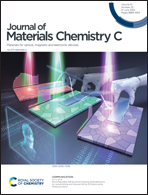Bright and stable quaternary ammonium antimony halides for solid-state lighting†
Abstract
Lead halide perovskites, as promising luminescent materials, have been studied extensively in recent years. However, the toxicity of lead and its reduced duration and color stability under operating conditions hinder the practical application of lead halide perovskites. Here, we report a new class of lead-free antimony halides, [CxH2x+1(CH3)3N]2SbCl5 (x = 8/10/12/14/16/18/22), using quaternary ammonium cations of different chain lengths to achieve tunable photoluminescence (PL) emission from 605 to 630 nm and a high PL quantum yield (QY) of up to 100%. The characterization of their photophysical properties demonstrates that the broadband emission (100–150 nm in full-width at half maximum) with a microsecond lifetime (5–9 μs) arises from the self-trapped emission (STE). Orange light-emitting diodes (LEDs) based on [C16H33(CH3)3N]2SbCl5 exhibit an ultrahigh luminous efficiency of 24.5 lm w−1 on a 365 nm UV LED chip and ultralong-term stability under continuous operation for 1200 minutes. Furthermore, through optimization of the mixture of these products with commercially available blue phosphors, the emission profiles of the white LEDs can be readily tuned from cold white (5722 K) and standard white (4500 K) to warm white (3349 K), with excellent color consistency.



 Please wait while we load your content...
Please wait while we load your content...